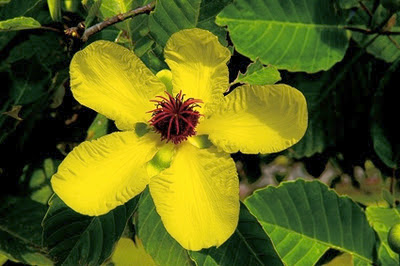"My Simpor Story PowerPoint Slide Show"
The Story of Simpor
Dillenia is a genus of about 100 species of flowering plants in the family Dilleniaceae, native to tropical and subtropical regions of southern Asia, Australasia, and the Indian Ocean islands.
The genus is named after the German botanist Johann Jacob Dillenius, and consists of evergreen or semi-evergreen trees and shrubs. The leaves are simple, spirally arranged. The flowers are solitary with five sepals and five petals, numerous stamens and a cluster of 5-20 carpels (wikipedia).
In Brunei Darussalam, eight species of Simpor are known, two of which, Dillenia beccariana (the River Simpor) which is depicted on the front side of Brunei One-dollar note and Dillenia suffruticosa (Simpor Bini), are more common.
The APEC 2000 website is still alive and has a nice description about the Bunga Simpur or Simpor as it is used in the article on the APEC 2000 website. It was written by Drs Idris M. Said of the Forestry Department, Ministry of Industry and Primary Resources.
To the Bruneians, “the unique blossoming of the flower and the green color of its leaves symbolizes the development” of the country’s “economy investment (from fruit) towards better economic growth (to flower).” (Dr.s Idris M. Said, Forestry Department - Ministry of Industry and Primary Resources).
The Dillenia beccariana or River Simpor (Common Name), is a species of a small tree fairly common along the rivers of Brunei, especially the Temburong River.
The Dillenia suffruticosa or Simpor Bini (Common Name) is another Simpor species that is also widespread in Brunei and can grow in various habitats. It can be found commonly in the white sands areas, as well in swamps. In the white sands, the Simpor Bini is a very important species as it acts as a pioneer species, colonizing the white sands where other tree species are unable to establish themselves on the white sands. The Simpor Bini is known to have seeds that can establish on the white sands and germinating that are able to send roots very deep down to reach underground water source. The low spreading shrubs that develop will eventually provide shade for seedlings of other tree species to establish themselves. After some time, the white sands will become a new rainforest.
The ripe fruit splits open also at 3 am, into pinkish star-shaped segments to reveal seeds covered in red arils.
The simpor plant blooms from age 3-4 and can live for 50-100 years! The inner bark of the Simpor is rather thick with radial lines and fairly loosely fibrous; it produces a hissing sound when cut, you will have to put your ear to hear it. The sound comes from the air that is sucked into the cut vessels which is a unique feature associated with the Simpor. The timber is not useful because it is twisted and very hard.
The simpor plant blooms from age 3-4 and can live for 50-100 years! The inner bark of the Simpor is rather thick with radial lines and fairly loosely fibrous; it produces a hissing sound when cut, you will have to put your ear to hear it. The sound comes from the air that is sucked into the cut vessels which is a unique feature associated with the Simpor. The timber is not useful because it is twisted and very hard.
Characteristics of Simpor
Main features: Large shrub or small tree. Grows up to 5m or 6m.
Leaves: Large (35cm long) oval leaves that are cabbage-like with slightly toothed edges.
Flowers: Large yellow, five petals.
Fruits: Red, splits open into segments; seeds covered with red flesh.
Distinguish between Fruits buds and Flowers buds: The fruits buds face upwards while flower buds face down.
Location in Brunei: Rivers of Brunei, white sands areas, swamps.
World distribution: Southern Asia, Australasia, and the Indian Ocean islands.
Classification: Family Dilleniaceae.
Part of Simpor Flower
General Uses
There were a variety of traditional uses attributed to the Simpor. The Simpor Bini was used for the treatment of wounds in stopping bleeding, making it very important for the society, and the pulp of the fruits of a certain species may be used for hair wash in Brunei.
It is also used in Bruneian art known as “Ayer Muleh", an artistic design for decoration of traditional handicrafts but which is more widely used in the printed form.
The flowers are sometimes eaten. The usually large and stiff leaves of Simpoh Air were sometimes used to wrap food such as tempeh (fermented soyabean cake), or folded into a shallow cones to contain traditional food such as rojak.
The mature or old leaves of some species contain a deposit of silica in their tissues and thus they were once used as sandpaper.
This significant ecological role of the Simpor is something which should be given due appreciation. The Simpor Bini is an indicator of underground water source, and traditionally some wells were dug based on the presence of the Simpor Bini.
References
Cuneta, J.C. (2007), Brunei National Flower – Simpor. Retrieved on 26th October 2011,
http://jcsesecuneta.com/snoworld/brunei-national-flower-simpor
Cuneta, J.C. (2007), Brunei National Flower – Simpor. Retrieved on 26th October 2011,
http://jcsesecuneta.com/snoworld/brunei-national-flower-simpor
Brunei’s National Flower. Retrieved on 26th October 2011,
http://bruneiresources.blogspot.com/2009/09/bruneis-national-flower.html
http://bruneiresources.blogspot.com/2009/09/bruneis-national-flower.html








